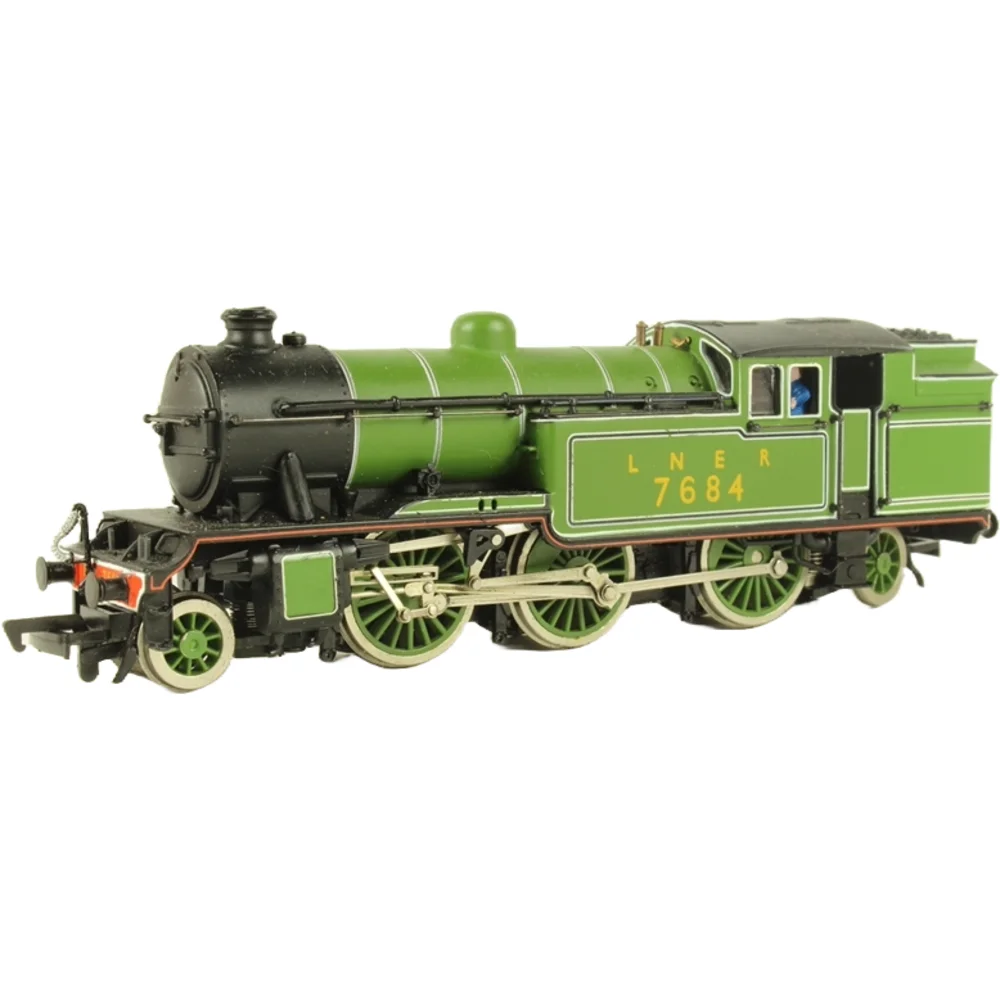Bachmann 31-600
London & North Eastern Railway V3 7684 London & North Eastern Railway Lined Apple Green
Tooling
The Bachmann Branchline V1/V3 2-6-2T was introduced in 1991–92 as part of Bachmann’s early OO gauge range following their acquisition of Mainline tooling. These suburban tank locomotives, designed by Sir Nigel Gresley for the LNER, were popular for their versatility on passenger and mixed-traffic duties. At the time, the model represented a significant step forward in British RTR steam locomotives, though it retained the split-chassis technology typical of the era.
Tooling Features
- Scale: OO gauge (1:76), designed for 16.5mm track.
- Construction: Plastic bodyshell with moulded details; cab glazing was basic and recessed.
- Detailing: Integral handrails, moulded rivets, and simplified pipework. No separately fitted parts typical of later “super-detail” models.
- Couplings: Tension-lock couplers mounted on the chassis; no NEM pockets.
Mechanical & Electrical
- Chassis: Split-chassis design with electrical pickup through the chassis halves.
- Motor: Mabuchi FK130 can motor driving the centre axle via gears; praised for longevity.
- Drive: All three driving axles powered; reasonable haulage for its size.
- Minimum Radius: Recommended 2nd radius (approx. 438mm).
- Lighting: None.
- Weighting: Moderate weight from chassis block; adequate for suburban trains.
DCC Capability
Not DCC-ready. Hard-wiring a decoder was considered impractical due to the split-chassis design, making conversion difficult and rarely attempted.
Liveries Produced
- LNER Apple Green (1923–1947)
- LNER Black (1923–1947)
- BR Plain Black (1948–1980)
- BR Green with Early Emblem (1948–1957)
- BR Black with Early Emblem (1949–1957)
- BR Black with Late Crest (1957–1968)
Reviews & Commentary
At launch, the model was considered robust and good value, though detailing was basic compared to later standards. Enthusiasts praised its running qualities when new, but over time issues emerged:
- Strengths: Smooth running when well-maintained; durable motor.
- Weaknesses: Vulnerable to split-chassis deterioration (cracked plastic muffs, worn plating); poor cab detail; heavy moulded features.
Modern reviewers often describe it as “outdated but nostalgic,” noting its place between Airfix-era tooling and contemporary super-detail models.
Media & Social Media
Video reviews and forum discussions highlight the model’s historical significance and mechanical reliability, but caution against second-hand purchases due to age-related failures. Popular YouTube channels have featured the V1/V3, often labelling it “worst detail but best runner” among older Bachmann tanks.
Interesting Notes
- The tooling remained in production until the mid-2000s before being replaced by a fully retooled version in 2016.
- Collectors value mint boxed examples for nostalgia rather than operational use.
Class & Prototype
- Class: London & North Eastern Railway V3
- Traction: Steam
- Built: 1939-1940
- Total Built: 10
- Running Number: 7684
Operator & Livery
- Operator: London & North Eastern Railway
- Livery: Lined Apple Green
- Era: 3 - The big 4 – LMS, GWR, LNER & SR
The London & North Eastern Railway emerged in 1923 as Britain's second-largest railway company, combining seven major railways including the Great Northern, North Eastern, and Great Eastern into a 6,590-mile network stretching from London's four terminals to the Scottish Highlands. Despite serving economically challenged industrial regions, the LNER achieved worldwide recognition for engineering excellence and speed records that remain unbroken today.
Under Chief Mechanical Engineers Sir Nigel Gresley, Edward Thompson, and Arthur Peppercorn, the LNER developed revolutionary locomotive designs characterised by three-cylinder layouts and streamlined aesthetics. Gresley's masterpieces included the A1 Pacifics featuring Flying Scotsman and the legendary A4 class, culminating in Mallard's world steam speed record of 126 mph in 1938.
The company pioneered luxury express services including the Silver Jubilee and Coronation streamliners, whilst investing in forward-thinking electrification schemes and massive marshalling yards. Notable achievements included operating the complete East Coast Main Line, introducing Britain's first regular 400-mile non-stop service, and commissioning Eric Gill's iconic typography that influenced railway design for decades.
Nationalised in 1948, LNER locomotives continued serving British Railways until the 1960s, with some A4 Pacifics working Scottish expresses until 1966. Today, the LNER's engineering legacy thrives through extensive preservation, new-build projects like Tornado, and comprehensive model ranges covering every major class in all popular scales, making LNER subjects essential for discerning railway modellers seeking authentic British steam-age atmosphere.
